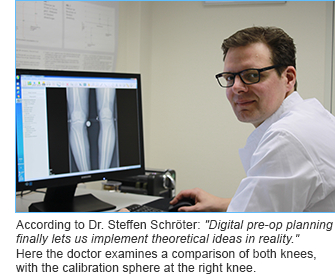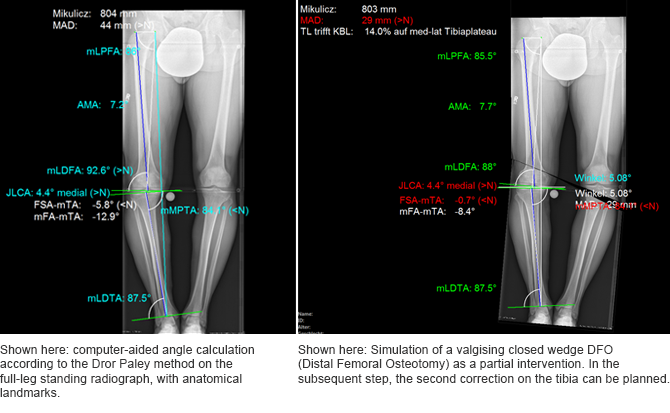



Published, 29.08.2022
Occupational Injury Clinic in Tübingen chooses mediCAD
Surgeons who utilize digital planning enjoy numerous benefits, including secure storage of the planning data, time savings, and higher quality.

But for Dr. Steffen Schröter, Head of the Sports Traumatology and Arthroscopic Surgery department at the Occupational Injury Clinic in Tübingen, Germany, the real benefits of digital planning come from the new opportunities it provides. The clinic for Trauma and Restorative Surgery has been using mediCAD Classic® from hectec GmbH since the hospital launched the Agfa PACS in 2008. With the digital planning solution, implants and related components in PACS can be overlayed on the radiographs. For example, a suitable cup and shaft combination can be efficiently planned on the system in preparation for a hip operation. For hectec, having the world’s largest database of implants comes in handy. It includes approximately 450,000 templates from more than 100 manufacturers, with new data added all the time.
The manufacturer has been refining this solution since 1999. It is a certified program and has global approval as a medical product. mediCAD Classic® incorporates all common planning methods and documents processes for legal security. Beyond the scope of pre-op planning, mediCAD’s extensive measurement capabilities have made it a valuable diagnostic tool.
Simulation boosts quality
The trauma center in Tübingen is especially fond of the program’s simulation capabilities for corrective osteotomies of deformities. In the past, the axes on the radiograph were measured using a protractor, but now the computer handles this task. It works faster and – more importantly – much more accurately. With a conventional radiograph, analyzing a deformity in detail required a great deal of effort. Only simple methods were available for planning the correction at the tibia head. This resulted in inaccurate planning. But now highly precise planning is possible. Various implants, plates, and angles can be simulated to observe their effects on the geometry of the leg. The surgeon can then compare two or three planning options and choose the most optimal variation for the operation. “The whole process takes maybe a half hour,” according to Dr. Schröter. “This has existed in theory for quite some time, but digital planning now allows us to turn theory into reality.” For osteotomies, correction of collateral ligament instabilities (caused by degraded cartilage, for example) can be simulated. The simulation improves the quality of the operation by accounting for the patient’s individual physiological and anatomical characteristics.
Even joint-specific and nontypical planning, for situations like supramalleolar corrective osteotomies and leg elongations with motorized pins, can be planned and much more. Even more important is simulation of the changes to the joint axes, for example, during distraction.
Clear graphical images
In addition to the many functional benefits, digital planning also saves a tremendous amount of time during day-to-day activities. But automatic documentation of deformity analyses does even more than just save time. It also gives the surgeon the legal security that comes with the ability to objectively and completely track every step. Digital planning is easy to discuss with colleagues and can be used for educational and training purposes. When meeting with the patient, having an easy-to-understand graphical image makes it easier for the patient to understand each step of the operation. “Before” and “After” comparisons allow the surgeon and patient to jointly discuss the operation.

Every year, the hospital plans approximately 160 deformity corrections with mediCAD®, which is installed on two computers.